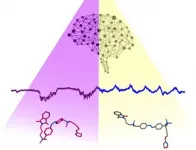(Press-News.org) Only 2% of vehicles are electrified to date, but that is projected to reach 30% in 2030. A key toward improving the commercialization of electric vehicles (EVs) is to heighten their gravimetric energy density - measured in watt hours per kilogram - using safer, easily recyclable materials that are abundant. Lithium-metal in anodes are considered the "holy grail" for improving energy density in EV batteries compared to incumbent options like graphite at 240 Wh/kg in the race to reach more competitive energy density at 500 Wh/kg.
Yan Yao, Cullen Professor of electrical and computer engineering at the Cullen College of Engineering at the University of Houston, and UH post doctorate Jibo Zhang are taking on this challenge with Rice University colleagues. In a paper published June 17 in Joule, Zhang, Yao and team demonstrate a two-fold improvement in energy density for organic-based, solid state lithium batteries by using a solvent-assisted process to alter the electrode microstructure. Zhaoyang Chen, Fang Hao, Yanliang Liang of UH, Qing Ai, Tanguy Terlier, Hua Guo and Jun Lou of Rice University co-authored the paper.
"We are developing low-cost, earth-abundant, cobalt-free organic-based cathode materials for a solid-state battery that will no longer require scarce transition metals found in mines," said Yao. "This research is a step forward in increasing EV battery energy density using this more sustainable alternative." Yao is also Principal Investigator with the Texas Center for Superconductivity at UH (TcSUH).
Any battery includes an anode, also known as negative electrode, and a cathode, also known as positive electrode, that are separated in a battery by a porous membrane. Lithium ions flow through an ionic conductor - an electrolyte, which allows for the charging and discharging of electrons that generates electricity for, say, a vehicle.
Electrolytes are usually liquid, but that is not necessary - they can also be solid, a relatively new concept. This novelty, combined with a lithium-metal anode, can prevent short-circuiting, improve energy density and enable faster charging.
Cathodes typically determine the capacity and voltage of a battery and are subsequently the most expensive part of batteries due to usage of scarce materials like cobalt - set to reach a 65,000-ton deficit in 2030. Cobalt-based cathodes are almost exclusively used in solid-state batteries due to their excellent performance; only recently have organic compound-based lithium batteries (OBEM-Li) emerged as a more abundant, cleaner alternative that is more easily recycled.
"There is major concern surrounding the supply chain of lithium-ion batteries in the United States," said Yao. "In this work, we show the possibility of building high energy-density lithium batteries by replacing transition metal-based cathodes with organic materials obtained from either an oil refinery or biorefinery, both of which the U.S. has the largest capacity in the world."
Cobalt-based cathodes generate 800 Wh/kg of material-level specific energy, or voltage multiplied by capacity, as do OBEM-Li batteries, which was first demonstrated by the team in their earlier publication, but previous OBEM-Li batteries were limited to low mass fraction of active materials due to non-ideal cathode microstructure. This capped total energy density.
Yao and Zhang uncovered how to improve electrode-level energy density in OBEM-Li batteries by optimizing the cathode microstructure for improved ion transport within the cathode. To do this the microstructure was altered using a familiar solvent - ethanol. The organic cathode used was pyrene-4,5,9,10-tetraone, or PTO.
"Cobalt-based cathodes are often favored because the microstructure is naturally ideal but forming the ideal microstructure in an organic-based solid-state battery is more challenging," said Zhang.
On an electrode level, the solvent-assisted microstructure increased energy density to 300 Wh/kg compared to the dry-mixed microstructure at just under 180 Wh/kg by improving the utilization rate of active material significantly. Previously, the amount of active materials could be increased but the utilization percentage was still low, near 50%. With Zhang's contribution, that utilization rate improved to 98% and resulted in higher energy density.
"Initially I was examining the chemical properties of PTO, which I knew would oxidize the sulfide electrolyte," Zhang said. "This led to a discussion on how we might be able to take advantage of this reaction. Together with colleagues at Rice university, we investigated the chemical composition, spatial distribution and electrochemical reversibility of the cathode-solid electrolyte interphase, which can provide us hints as to why the battery could cycle so well without capacity decay," Zhang said.
Over the last ten years, the cost of EV batteries declined to nearly 10% of their original cost, making them commercially viable. So, a lot can happen in a decade. This research is a pivotable step in the process toward more sustainable EVs and a springboard for the next decade of research. At this rate, perhaps just as literally as euphemistically, the future looks much greener on the other side.
INFORMATION:
This research was funded by the US Department of Energy's Office of Energy Efficiency and Renewable Energy (EERE), as part of the Battery 500 Consortium.
MIAMI--In a new analysis on managed retreat--the climate adaptation response of moving people and property out of harm's way--researchers explore what it would take for managed retreat to be supportive of people and their priorities. A key starting point is considering retreat alongside other responses like coastal armoring and not just as an option of last resort.
In a new paper in the journal Science, University of Miami (UM) Rosenstiel School of Marine and Atmospheric Science researcher Katharine Mach argues that managed retreat should be viewed as a proactive option that can support communities and livelihoods in the face of climate change.
"Managed retreat ...
The surface of a material often has properties that are very different from the properties within the material. For example, a non-conducting crystal, which actually exhibits no magnetism, can show magnetisation restricted to its surface because of the way the atoms are arranged there. These distinct properties at interfaces and surfaces of materials often play a key role in the development of new functional components such as optoelectronic chips or sensors and are therefore subject to extensive research. An international research team from the University of Göttingen, the Max Planck Institute for Biophysical Chemistry Göttingen and the National Research Council Canada has now succeeded in investigating the surfaces of transparent crystals using ...
Understanding cellular metabolism - how a cell uses energy- could be key to treating a wide array of diseases, including vascular diseases and cancer.
While many techniques can measure these processes among tens of thousands of cells, researchers have been unable to measure them at the single-cell level.
Researchers at the University of Chicago's Pritzker School of Molecular Engineering and Biological Sciences Division have developed a combined imaging and machine learning technique that can, for the first time, measure a metabolic process at both the cellular and sub-cellular levels.
Using a genetically encoded biosensor paired with artificial intelligence, ...
PHILADELPHIA - Sour taste does not have the nearly universal appeal that sweet taste does. Slightly sour foods or drinks such as yogurt and lemon juice are yummy to many, but such highly sour foods as spoiled milk are yucky, even dangerous. Like humans, many other animals, including insects, prefer slightly acidic over very acidic foods.
Evolutionary biologists surmise that the need for sour detection to be finely tuned is a two-sided coin: slightly acidic foods can enhance digestion and stimulate saliva production; relative sour-to-sweet taste can signal optimal ripeness of fruit; and extremely sour food, as with bitter taste, is a warning to what not to ingest. However, despite this usefulness, how do animals discern different concentrations ...
The brain presents different states depending on the communication between billions of neurons, and this network is the basis of all our perceptions, memories, and behaviours. It is often considered a "black box", with difficult access for clinicians and researchers, as few limited tools are available to perform accurate and spaciotemporal studies on brain neuronal behaviour. Now, researchers from the Institute for Bioengineering of Catalonia (IBEC) in collaboration with August Pi i Sunyer Biomedical Research Institute (IDIBAPS) and have added some light to the subject: they succeeded for the first time in controlling neuronal activity in the brain using a molecule responsive to light.
The study included participants ...
MADISON - In early January 2021, travelers returning to Tokyo, Japan, from Amazonas, Brazil, were screened for COVID-19 at the airport. A few days later, the National Institute of Infectious Disease of Japan announced that the travelers had returned with a new variant of the SARS-CoV-2 virus.
That variant, known as gamma, or P.1, led to a deadly surge in COVID-19 cases in Brazil this spring, and has now spread across the world. More than 200 cases have been detected in Wisconsin. Whether current vaccines are as effective against the gamma variant remains unknown.
In a new study using variant virus recovered from one of the original travelers, ...
University of Delaware disaster researcher A.R. Siders said it's time to put all the options on the table when it comes to discussing climate change adaptation.
Managed retreat -- the purposeful movement of people, buildings and other assets from areas vulnerable to hazards -- has often been considered a last resort. But Siders said it can be a powerful tool for expanding the range of possible solutions to cope with rising sea levels, flooding and other climate change effects when used proactively or in combination with other measures.
Siders, a core faculty member in UD's Disaster Research Center, and Katharine J. Mach, associate professor at the University ...
KIYATEC, Inc. announced today the publication of new peer-reviewed data that establishes clinically meaningful prediction of patient-specific responses to standard of care therapy, prior to treatment, in newly diagnosed glioblastoma (GBM) and other high-grade glioma (HGG) patients. The results, the interim data analysis of the company's 3D-PREDICT clinical study, were published June 16, 2021 in Neuro-Oncology Advances, an open access clinical journal.
A goal of the study, which continues to enroll, was for the test's prospective, patient-specific response prediction to achieve statistical significance for ...
Researchers from Bentley University, in partnership with Waltham Council on Aging in Massachusetts, and as part of a study funded by the National Science Foundation, have been exploring how the elderly use smart speakers at home. Waltham, a satellite city about eight miles west of Cambridge has a population of about 60,000, with about one in six being an elderly citizen. The purpose of the study was to understand how the elderly use the smart speaker technology at home. A smart speaker is a hardware device that is always-on. When a wake-word triggers the software contained in the device, the smart speaker listens to the command to provide a response or carry out the command (accessing resources ...
When Ana K. Spalding, a Research Associate at the Smithsonian Tropical Research Institute (STRI) and Assistant Professor of Marine and Coastal Policy at Oregon State University (OSU) talks about mentorship in academia, she describes it as meaningful relationship. It goes beyond conversations about research and publications, and into shared experiences. This is just one approach--proposed by Spalding and 23 other women scientists from around the world, in a new article published in PLOS Biology--that calls for a shift in the value system of science to emphasize a more equal, diverse and inclusive academic culture.
The authors came together after reading a ...





